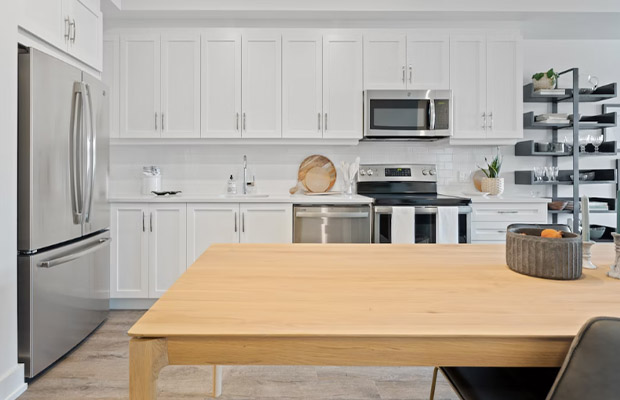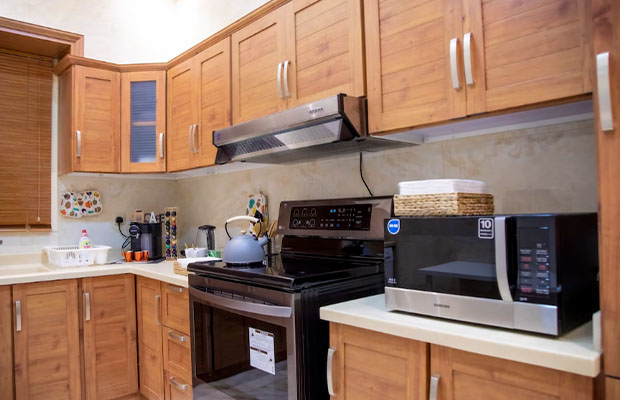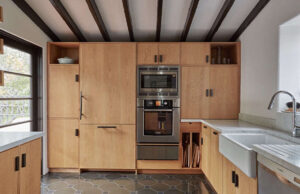The ideal location in your kitchen should be chosen for this necessary small appliance.
So where to put microwave in kitchen? Choose a spot close to the refrigerator, stove, and countertop. Since it’s so common to just pop something straight from the fridge into the microwave, you want to put the two appliances close to one another while still leaving enough room for a bench.
Listed below are nine ways to incorporate a microwave into your kitchen design as well as some common mistakes to avoid. Let’s start!
Table of Contents
Where To Put The Microwave In Your Kitchen?
1. Below the Counter
Having trouble finding enough space on your counters or upper cabinets? A microwave cabinet could be used in place of a lower drawer.
Pros: leaves the counter free of clutter and the sightline unobstructed, especially when combined with light upper shelving.
Cons: Moving dishes into and out of a low-level microwave can be a hassle. This could be a risky choice if you have young children who are naturally curious.
Construction considerations: Often, a suitable space can be created for practically no money by removing a large drawer front. Choose a microwave-ready base cabinet during construction for the same price as a regular drawer cabinet for the neatest fit.
2. Over the Range
Compared to a sleek hood fan, this choice isn’t always the most attractive, but it works well for maximizing a small area.
Pro: In a small kitchen, a microwave and hood-fan combination can serve two purposes.
Cons: Many users will have trouble reaching and seeing inside the microwave if it is too high. Additionally, it takes the place of a sculptural range hood for a somewhat less elegant appearance and typically vents less effectively.
Construction considerations: Try to purchase the microwave and range from the same supplier so that the finishes match as closely as possible. After that, installation is relatively simple and typically takes a few hours, depending on how long it takes to remove the old range, hood, and microwave and whether any counters or cabinetry need to be cut to make room for the new ones.
3. In a Spare Cabinet
This solution is incredibly simple to DIY. To keep the device out of the way when not in use, I used it in my own kitchen.
Pro: The microwave can be placed in this configuration at a reasonable price and at a convenient height (or in an unused cabinet to save space).
Cons: Those who are neat freaks will get upset if someone leaves the door open or leaves crumbs in the crevices. Those who use the microwave frequently might find it annoying to take an extra step to open the cabinet door.
Construction considerations: This is a relatively simple DIY project if a suitable cabinet is available; the only challenge is usually drilling a hole for the wiring to reach an existing plug. To prevent visible cords, a plug could be provided inside the cabinet if this was anticipated during construction. To make sure that the open door will adequately vent heat, check the microwave’s user manual.
4. Angled Corner Cabinet
a practical choice for large kitchens that would otherwise have unused deep corners.
Pros: faces the room and takes up a corner for convenience. uses a deep cabinet that might otherwise hold difficult-to-reach items more effectively.
Con: The area behind the microwave and any other appliances or drawers will have some unused space.
Construction considerations: In most cases, a corner cabinet is planned during construction and is difficult to add later. The price should not be significantly higher or lower than that of a standard cabinet if your cabinet system or company offers corner cabinet options.
5. At a Drinks Station
An intelligent choice for a butler’s pantry, a basement bar station, or another secondary kitchen.
Pro: In a busy household, moving the microwave to a side station places it close to the coffee maker for quick breakfasts or snacks and out of the way of the main cook.
Con: If you frequently cook, having the only microwave a long way from the refrigerator or main prep area is not ideal.
Construction considerations: Depending on how the microwave is mounted, the usual construction issues will be present. Consider highlighting the microwave as an accent rather than concealing it when it’s the only major appliance that can be seen.
6. Integrated Into Cabinetry
For those who adore the appearance of elegantly featured appliances, a chic custom option is available.
Pro: To maximize reachability, the height can be adjusted.
Con: The risk of having to hold a hot plate while having nowhere to set it quickly arises if it is put too far away from a counter.
Construction considerations: It’s challenging to retrofit unless a suitable cabinet already exists. To get the ideal height (or to accept one of your cabinet supplier’s standard options), you might need a customized cabinet. Additionally, a gorgeous trim kit will look amazing but be more expensive.

7. In the Island
makes smart use of the island, which would otherwise serve as storage for miscellaneous items, and conceals the microwave without completely hiding it.
Pros: keeps the main cabinets for storage. Additionally, you can place the microwave away from the main cooking area so that someone who isn’t doing the main cooking can use it without worrying about running into the person who is.
Con: It will be more difficult to reach a low microwave, especially if the counter has a deep lip.
Construction considerations: A microwave cabinet won’t cost much more if your island is made of lower cabinets, but you will need electrical run to the island, making this difficult to add to an existing island.
8. In an Appliance Garage
For those who want to conceal several appliances when not in use, this is a great, fashionable option.
Pro: To make them easier to access, keep small appliances hidden at counter height.
Con: when compared to simply keeping things on the counter, uses more space.
Construction considerations: The best option would be an extra-deep counter (30 inches instead of 24 inches) to leave usable space in front, but a short stretch of the counter can be retroactively converted into an appliance garage. If you’re adding a door afterward, use a contrasting finish (like metal) if you can’t match your current paint, or the style will be off. For a standard model, be prepared to spend up to a few hundred dollars, either during or after construction.
9. Over the Oven
A “chef’s kitchen”-style kitchen isn’t shy about showing off stainless steel appliances. It works well for striking a balance between a lot of classic wood and contemporary elements.
Pros: gives the appliances a cohesive grouping for a modern appearance. additionally enables a bigger microwave for heavier use.
Con: For some users, the oven may be too low or the microwave occasionally too high.
Construction considerations: This strategy typically needs to be customized. Adding a large microwave (or at least a sizeable trim kit) may cost hundreds of dollars or even more, depending on the quality.
Read More: Where Should Fridge Be in Kitchen?
Common Mistakes To Avoid
1. Never Place A Microwave Too Close To The Window
Any seasoned kitchen designer will tell you it’s not a good idea to place a microwave near a window frame.
“The general rule is to keep windows free of obstructions and away from heat-producing devices like cooktops and microwaves. In case of a fire, this appliance may be the difference between danger and safety at an exit,” says Microwaves do need adequate ventilation, but placing one in front of a window is not the solution, according to IKD designer Albert.
2. Keep A Microwave Out Of A Corner Cabinet
Traffic-heavy areas are frequently created by microwaves. To reheat, defrost, or soften ingredients or leftovers, you’ll frequently switch between the microwave and the refrigerator.
Unless your kitchen is specifically designed for an angled space, placing them in a corner is typically a bad idea. The microwave is not adequately supported in this design, and there is no airflow to allow for adequate ventilation. A better option for installation: The microwave is properly supported and has space for ventilation on both sides.
The cabinet will eventually fall off as a result of this grave error.
The microwave is cleverly installed, with space on both sides and support behind it.
3. A Microwave Against A Wall Is A Bad Idea
It can only get worse from here. Because this appliance only has one door, microwave ovens require a lot of space around them.
A microwave oven built into a small space may also be difficult to operate. IKD will take a close look at where the food should land so that your kitchen’s work triangle is functioning properly.
4. Don’t Put A Microwave Next To A Refrigerator
The placement of a microwave next to a refrigerator is also not recommended, especially if the refrigerator has two doors or one door that opens toward the microwave.
In this case, if you’re not careful, your microwave door could dent your fridge door. Observe: This might not be the worst idea if you have an IKEA refrigerator that is panel-ready.
The placement of a microwave next to a device that is intended to keep things cool may not be ideal because the microwave also generates a lot of heat.
5. A Microwave Next To A Sink Is Asking For Trouble
One of the worst places to put an appliance is right next to the sink.
Making sure that the microwave is always four to nine feet away from the sink is the solution. It’s significantly safer and just well-designed.
IKEA customers might not be aware of how important microwave placement is to the success of their kitchen design. Our design team is here to help you with the entire process and to concentrate on the design elements you might not have thought of.
Final Words
I hope this has helped you understand the advantages and disadvantages of placing your microwave. My recommendation is to make sure you seek the assistance of a professional kitchen designer from a business like ours if you’re installing or renovating a kitchen.
Attention to detail is crucial when they are giving you advice on your ideal kitchen; a microwave is a great illustration of this idea.


